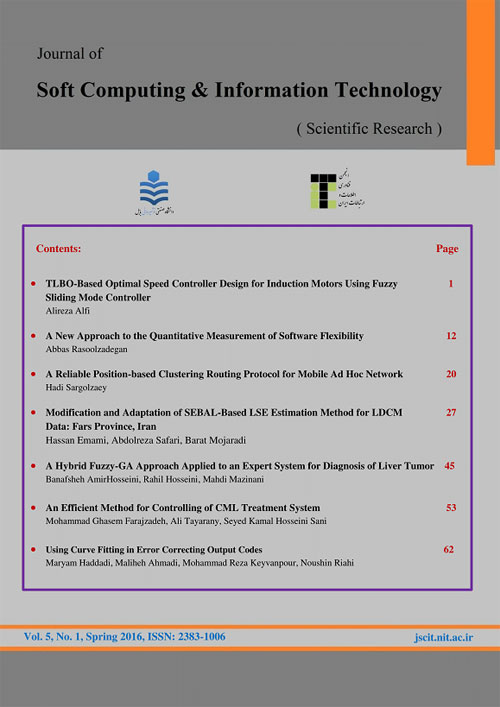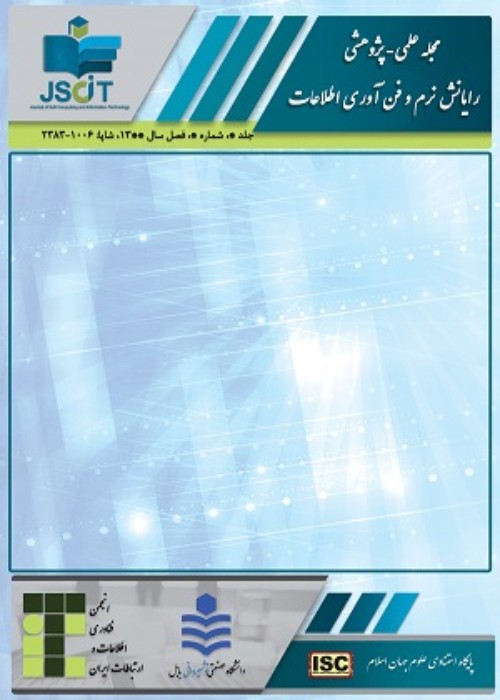فهرست مطالب

مجله رایانش نرم و فناوری اطلاعات
سال پنجم شماره 1 (بهار 1395)
- تاریخ انتشار: 1395/03/10
- تعداد عناوین: 7
-
-
بهبود و تطبیق روش مبتنی بر سبال در برآورد گسیلمندی سطح برای داده های لندست8: مطالعه موردی استان فارس، ایرانصفحات 27-44
-
صفحات 53-61
-
استفاده از برازش منحنی در کدهای خروجی تصحیح کننده ی خطاصفحات 62-69
-
Pages 1-11Teaching-Learning-Based Optimization (TLBO) algorithm is a new optimization technique which has been shown to be competitive to other population-based algorithms. In this paper, TLBO algorithm is employed for speed control of induction motor based on Fuzzy Sliding Mode Controller (FSMC). The proposed control method, namely Optimal Fuzzy SMC (OFSMC), formulates the design of FSMC as an optimization problem. First, a sliding mode speed controller with an integral switching surface is designed, in which the acceleration information for speed control is not required. In this case, the upper bound of the lumped uncertainties including parameter uncertainties and load disturbance must be available. The importance of this parameter regarding the system performance is illustrated. Then, the fuzzy sliding mode speed controller is utilized to estimate the upper bound of the lumped uncertainties. Finally, TLBO algorithm is employed to determine the optimal upper bound of these uncertainties. Simulation results are included to demonstrate that the proposed OFSMC can obtain better quality solution than many existing techniques like Proportional-Integrator (PI), SMC, FSMC and an Adaptive FSMC (AFSMC).Keywords: Induction motor, Sliding mode control, Teaching-learning-based optimization, Fuzzy control
-
Pages 12-19Software flexibility is the ease with which a software system can be modified for use in applications or environments other than those for which it was specifically designed. Software flexibility is not an absolute term. It is an important aspect of software quality. Quantifying software flexibility is increasingly becoming necessary. We have recently proposed a new approach (referred to as SDAFlex&Rel) to the development of reliable yet flexible software. In this paper, a new approach is proposed to quantitatively measure the flexibility of the software developed using SDAFlex&Rel, thereby making precise informal claims on the flexibility improvement. Moreover, the effectiveness of the proposed measurement approach is empirically investigated in the multi-lift case study that has already been conducted to demonstrate the feasibility of SDAFlex&Rel. The results confirm the flexibility improvement promised by SDAFlex&Rel.Keywords: flexibility, quantitative measurement, design patterns, software metrics
-
Pages 20-26Mobile Ad Hoc Network (MANET) is a special and attractive type of new wireless networks. It is an autonomous system that can dynamically be set up anywhere and anytime without using any pre-existing network infrastructure and its mobile hosts are free to move randomly. Host mobility in MANET causes failure of wireless links between nodes and breaks all the routes that use these links. Consequently, route reconstructions are needed, which is one of the most crucial issues for this type of wireless networks. There are two common solutions to this problem which increase the route reliability (lifetime) in MANETs; increasing the reliability of the links by using more reliable links and multipath route discovery. In this paper, both these schemes are used to develop a reliable unicast routing protocol for MANETs. As the first step, an efficient cross layer link reliability metric is proposed for reliable link selection. Reliable routing protocols for MANETs use many link reliability metrics for finding reliable links; four of the most commonly used are: Link Expiration Time, Probabilistic Link Reliable Time, Link Packet Error Rate and Link Received Signal Strength. The cross layer metric combines the aforementioned metrics by means of a weight function. The value of the weighting factors of this function are determined by the Response Surface Methodology. Next a reliable position based clustering routing protocol is designed. In this protocol the mobile nodes form disjoint sets of clusters, and for increasing the stability of these clusters, the aforementioned cross layer link reliability metric is used for cluster formation. A route is constructed and represented by a sequence of clusters and more reliable links are selected for data transfer inside and between the clusters. Because of the multiple links which usually exist between the clusters, multipath route scheme is used in this routing protocol in addition to the reliable link selection. Simulation results show that by using this protocol the lowest number of route reconstructions is achieved in comparison with the other related protocols.Keywords: MANET, Reliable Routing, Long Lifetime Route, Link Reliability Metric
-
Modified and Adaptation of SEBAL Methodology for Estimating LSE from LDCM Data: Fars Province, IranPages 27-44Land Surface Emissivity (LSE) is an important intrinsic property of materials which is variable through physical parameters and it is dependent to the Spectral Response Function (SRF) and the effective wavelength of channel. Surface Energy Balance Algorithm for Land (SEBAL) is one of the most widely applied models which is comprised of twenty-five sub-models that calculate different surface variables such as LSE and LST. This algorithm used within 3-14 μm and 8-14 μm spectral domain. Obviously, using of the broadband emissivity in one channel instead of the narrowband emissivity lead to large errors on the surface parameters. This study investigates the effects of SRF and effective wavelength on SEBAL-based LSE estimation method, MLSESEBAL, in the narrow domain of TIRS bands of LDCM. For comparison and validation of MLSESEBAL, it compared to three common LSE estimation methods and LSE product of ASTER as a reference, respectively. The results showed that if there is little difference in the effective wavelength between broadband and narrowband, the LSE estimation is almost identical in the non-vegetated area and there is no significant difference, while it is non-negligible in the vegetated area. In contrast, if there is a relatively large difference between the effective wavelength and SRF between them, in this case, areas with vegetation and no vegetation have the same performance and the greatest difference in LSE estimation. Moreover, the validation results of MLSESEBAL method showed that the RMSE of LSE are 1.59% and 1.21% in thermal band 10 of the first and second examined scenes, respectively. As well as, for the band 11, the error values are 1.56% and 0.98% in the two examined scenes, respectively.Keywords: Surface Energy Balance Algorithm for Land, Land surface emissivity, Land surface temperature, Landsat Data Continuity Mission, Thermal Infrared Sensor, ASTER
-
Pages 45-52Applications of soft computing techniques have been concentrated for management of the uncertainty associated to the medical diagnosis in the recent decade. This article presents a Fuzzy Expert System (FES) for diagnose of metastasis in the liver which is one of the most common malignant hepatic tumors. Furthermore, the proposed FES has been optimized using a genetic algorithm. The purpose of the hybrid fuzzy-GA approach is to adjust the FES parameters to enhance the system accuracy while the system interpretability has been kept. To experiment the proficiency of the intelligent Fuzzy-GA model, the performance of the system was evaluated with real dataset of patients gathered from the Noor Medical Imaging Center in Tehran. The FES performance was compared to the diagnosis of specialists before and after optimization with the GA. The results demonstrate that this system has a high capability in the management of uncertainty in the diagnosis with a high accuracy. The hybrid fuzzy-GA approach for hepatic tumors diagnosis is promising to assistant the specialists for early diagnosis of the cancer and saving more lives.Keywords: Soft computing, Fuzzy Inference System, Fuzzy-GA, Genetic Algorithm, Hepatic metastasis, Computer Aided medical diagnosis
-
Pages 53-61Chronic myelogenous leukemia (CML) is a kind of blood cancer, which produces abnormal white blood cells uncontrollably. Modeling of this type of disease can help for treatment of it to physicians. In this paper we proposed an efficient method for CML treatment. In this method, a nonlinear multivariable system is considered as the plant of the CML treatment. Then an efficient centralized multi-input multi-output proportional and integral (CMIMOPI) controller is proposed for this system. Results show that proposed CMIMOPI controller can control CML disease well, by using low dosage of drugs. Although the real plant is nonlinear, however the controller has good robustness and can stabilize the system for various conditions. Simulation results show that the steady state population of cancer cells at the end of treatment period is highly reduced and the rate of cancer improvement is independent from reproduction of cancer cells.Keywords: Chronic Myelogenous Leukemia (CML) treatment, Disease Modelling, MIMO system, Centralized controller, PI controller
-
Using Curve Fitting in Error Correcting Output CodesPages 62-69The Error Correcting Output Codes (ECOC) represent any number of the binary classifiers to model the multiclass problems successfully. In this paper, we have used Curve Fitting as a binary classifier in ECOC algorithm to solve multiclass classification problems. Curve Fitting is a classifier based on a nonlinear decision boundary that separates two pattern classes by the curves of the best fit, and arriving at optimal boundary points between two classes. Since we need a coding and a decoding strategy to design an ECOC system, this paper gives five coding and eight decoding strategies of ECOC and compares the results of Curve Fitting with Adaboost classification and Nearest Mean Classifier (NMC). This evaluation has been performed on different data sets of UCI machine learning repository. The results indicate that One-versus-one, ECOC-ONE coding and LAP, BDEN decoding having the best results in contrast with another coding and decoding strategies and Curve Fitting is a good base classifier in ECOC, also it is comparable with the other ECOC approaches.Keywords: Classifier, Coding, Curve Fitting, Decoding, Error Correcting Output Codes (ECOC)


